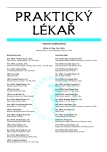Current strategy to pneumococcal conjugate vaccine immunization
Authors:
R. Prymula 1; K. Pospíšilová 2
Authors‘ workplace:
Fakulta vojenského zdravotnictví UO, Hradec Králové
; Infekční klinika, FN L. Pasteura, Košice
2
Published in:
Prakt. Lék. 2008; 88(2): 104-107
Category:
Of different specialties
Overview
Streptococcus pneumoniae causes diversiform scale of various diseases in childhood ranging from the most serious invasive like meningitis and septicemias (bacteriemias) through pneumonias up to life as a rule not threatening but all the more frequent acute otitis and sinusitis. Incidence of invasive pneumococcal diseases varies in different countries. Either the mass immunization strategy or risk group strategy are applied in the EU in current situation. However the risk group strategy is only an interlink in transition to the mass strategy. Among the mass European strategies schedules 2+1 or 3+1 are put on. The disadvantage of 2+1 strategy are regrettably in some degree lower antibody levels in sérotypes 6B a 23F, which massively appear in the Czech Republic and introduction of this schedule could limit its effectiveness. Administration of single or two-dose regimens, which are economically profitable, however they do not cover the major risks in categories of youngest kids, is not taken into consideration in children above 1 year of age in flat way as in meningococci. In spite of logically only one, recently registered 7-valent pneumoccocal conjugate vaccine asserts in current strategies, very soon we can probably expect conjugate vaccines containing more sérotypes and other protein carriers (10-valent GSK vaccine and 13-valent Wyeth vaccine). In far future are protein vaccines, which will not be type-specific or vaccines with intranasal or oral way of administration.
Key words:
Pneumococci, invasive pneumococcal diseases, acute otitis media, pneumococcal conjugate vaccine, immunogenicity, reactogenicity, mass immunization.
Sources
1. Hausdorff, W.P., Siber, G., Paradiso, P.R. Geographic differences in invasive pneumococcal disease rates and sérotype frequency in young children. Lancet 2001, 357, p. 950-952.
2. Hausdorff, W.P. Invasive pneumococcal disease in children: geographic and temporal variations in incidence and sérotype distribution. Eur. J. Ped. 2002, 161, (Suppl. 2), p. 135-139.
3. Konradsen, H.B., Kaltoft, M.S. Invasive Pneumococcal Infections in Denmark from 1995 to 1999: Epidemiology, Sérotypes, and Resistence. Clinical and Vaccine Imunology 2002, 9, 2, 358-365.
4. Prymula, R., Peeters, P., Chrobok, V. et al. Pneumococcal capsular polysaccharides conjugated to protein D for prevention of acute otitis media caused by both Streptococcus pneumoniae and non-typable Haemophilus influenzae: a randomized double-blind efficacy study. Lancet 2006, 367, p. 740-748.
5. Vergison, A., Tuerlinckx, D., Verhaegen, J., Malfroot, A. For the Belgian Invasive Pneumococcal Disease Study Group: Epidemiologic Features of Invasive Pneumococcal Disease in Belgian Children: Passive Surveillance Is Not Enough. Pediatrics 118, 3, September 2006.
6. Hausdorff, W.P., Bryant, J., Paradiso, P.R., Siber, G.R. Which Pneumococcal Serogroups Cause the Most Invasive Disease: Implications for Conjugate Vaccine Formulation and Use, Part I. Clinical Infectious Diseases, 2000, 30 p. 100-121.
7. Hausdorff, W.P., Bryant, J., Kloek, C., Paradiso, P.R., Siber, G.R. The Contribution of Specific Pneumococcal Serogroups to Different Disease Manifestations: Implications for Conjugate Vaccine Formulation and Use, Part II. Clinical Infectious Diseases 2000, 30, p. 122-140.
8. Kronenberg, A., Zucs, Droz, S., Muhlemann, K. Distribution and Invasiveness of Streptococcus pneumoniae Sérotypes in Switzerland, a Country with Low Antibiotic Selection Pressure,from 2001 to 2004. J. Clin. Microbiol 2006, 44, 6, p. 2032-2038.
9. Motlová J. Distribuce sérotypů a séroskupin Streptococcus pneumoniae u pacientů s invazívními pneumokokovými onemocněními v České republice v letech 1996–2003: podklady pro vakcinační strategii. Epidemiol. Mikrobiol. Imunol. 2005, 1 (54), p. 3-10.
10. Rendi-Wagner, P., Georgopoulos, A., Kundi M., Mutz I., Mattauch M., Nowak, J., Mikolášek A., Vecsei, A., Kollaritsch H. Prospective surveillance of incidence, sérotypes and antimicrobial susceptibility of invasive Streptococcus pneumoniae among hospitalized children in Austria. J. of Antimicrob. Chemoter. 2004, 53, 5, p. 826-831.
11. Eskola, J., Kilpi, T., Palmu, A., Jokinen, J., Haapakoski, J., Herva, E., Takala, A., Kayhty, H., Karma, P., Kohberger, R., Siber, G., Makela, P.H., Lockhart, S., Ecrola, M. Efficacy of a pneumococcal conjugate vaccine against acute otitis media. New Engl J. Med. 2001; 344 (6), p. 403-409.
12. Fireman, B., Black, S., Shinefield, H., Lee, J., Lewis, E., Ray, P. Impact of the pneumococcal conjugate vaccine on otitis media. Pediatr. Infect. Dis. J. 2003, 22 (1), p. 10-16.
Labels
General practitioner for children and adolescents General practitioner for adultsArticle was published in
General Practitioner

2008 Issue 2
- Memantine Eases Daily Life for Patients and Caregivers
- Metamizole vs. Tramadol in Postoperative Analgesia
- Metamizole at a Glance and in Practice – Effective Non-Opioid Analgesic for All Ages
- Memantine in Dementia Therapy – Current Findings and Possible Future Applications
- What Effect Can Be Expected from Limosilactobacillus reuteri in Mucositis and Peri-Implantitis?
Most read in this issue
- Memory and its disturbances
- Current possibilities and problems of antiretroviral therapy
- The hoarding of possessions and animals
- Acute toxic hepatitis following consumption of a herbal preparation
